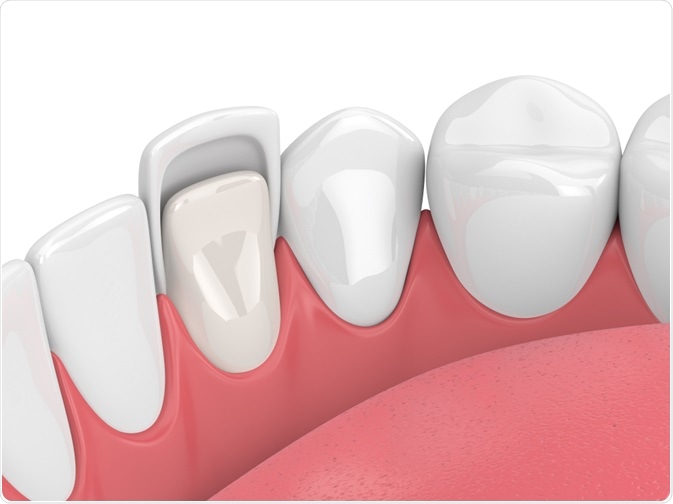A dental veneer is a tooth-colored coating that is professionally applied on the outer visible portion of a tooth to make it aesthetically pleasing. It can be used to correct dental erosion, discolored teeth or conditions that cause misaligned teeth.
 Aleksandra Gigowska | Shutterstock
Aleksandra Gigowska | Shutterstock
There are two types of aesthetic veneers; partial and full. Partial veneers are applied when the tooth defect is minimal, whereas full veneers are applied when the dental defect covers the major visible portion of the tooth surface.
How are veneers applied?
Veneers are either prepared from porcelain or from composite resins, which are tailored to each patient’s requirement. Porcelain veneers are thin and resemble artificial fingernails. They are carefully applied by a dentist and are bonded perfectly on the outer most visible portion of the tooth. Composite resin veneers are applied layer-wise and each layer is perfectly curated by the dentist to give a natural tooth-like appearance.
Direct veneer procedure
Direct Partial Veneer
These veneers are applied for localized dental defects. They cover a small portion of the tooth surface. Direct veneers can easily cover the defects caused due to enamel hypoplasia, specifically in the visible portion of the anterior teeth. Steps involved in the application of direct partial veneers include:
- Appropriate cleaning of the tooth surface
- Veneer shade selection under natural light
- Isolating the dental site with cotton rolls to prevent contamination from saliva
- Local anesthesia depending upon the extent of tooth damage
After completion of the above steps, tooth preparation is done so that partial veneer can stick appropriately on the desired site. After tooth preparation, etching is performed. Finally, the partial veneer is placed to cover the enamel defect.
Direct Full Veneers
Dental defects like widespread enamel hypoplasia, which usually involves the anterior upper jaw teeth, are treated with direct full veneers. A gap between two teeth can also be corrected with the help of direct full veneering technique. If more than two teeth are involved, then this procedure can be completed in two stages. Steps involved in placing direct full veneers are listed below:
- Selection of shade
- Post selection, enamel preparation is done by isolating the operated site with cotton rolls or with retraction cords
- Post tooth preparation, other procedures like etching, rinsing, and drying are executed
- The final procedure involves applying the bonding agent to fix the composite veneer.
- In case multiple teeth are involved, the dentist usually finishes the first tooth and then moves on to the second tooth for veneer placement
Placing direct composite veneer demands patience, both from the dentist and from the patient. This procedure involves the placement of veneer layer-wise. If multiple teeth are involved, then it may require several sittings to complete the procedure.
What are indirect veneers and how are they applied?
Placement of direct veneers can be a time-consuming and complex dental procedure. Hence, many dentists prefer indirect veneers. Indirect veneers are prepared in the dental laboratory and can be made of the processed composite or porcelain material.
Usually, two dental appointments are required to complete the procedure, but overall office time is reduced, as the veneer preparation is mostly performed in the dental laboratory. Steps involved in placing the direct veneers are as follows:
- Local anesthesia may or may not be administered, depending on factors like tooth sensitivity during the cavity preparation. In this procedure, minimal enamel is removed, and space is created for the application of veneer.
- Shade selection is done and a dental impression is taken. Impression is sent to the dental laboratory for preparing a direct veneer
- Meanwhile, a temporary veneer is placed until the final veneer is received
- Once the final veneer is ready, the temporary veneer is removed and the desired tooth is cleaned thoroughly. This process is followed by steps like etching, drying, and placement of veneer with the bonding agent
- Finally, the veneer is fixed firmly with the help of a light cure for about 60 seconds, and excess material is removed and margins are polished well with the help of dental instruments
What measures can be taken to keep veneers in place?
Veneers can instantaneously cover up defective and discolored portions of teeth. However, it is important to note that veneers are not a permanent cure for these dental issues.
Aesthetic veneers are prone to damage, wear and tear, or discoloration if they are not cared for. The best ways to prevent damage are; brushing twice daily, using less abrasive fluoride toothpaste, and limiting the intake of foods and beverages causing staining can prevent the damage to veneers.
Further Reading